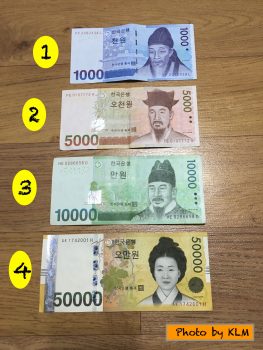People on the South Korean Bills (Banknotes) Posted by Kyung-Hwa on Sep 20, 2017 in Korean Language, Vocabulary
When you travel to different countries, what do you see on the various bills and coins? Many countries feature important people, symbols, or monuments in order to encapsulate their essential history and culture. Do you know who is on the South Korean bill? Every time you use Korean banknotes, you will see important Korean people on these. Are you ready to find out who is on the different South Korean bills?
Last week was about the official monetary unit of South Korea, 원 (won), and four different kinds of Korean bills (banknotes) and their values.

1. 천 원 (₩ 1,000 – one thousand won)
2. 오천 원 (₩ 5,000 – five thousand won)
3. 만 원 (₩ 10,000 – ten thousand won)
4. 오만 원 (₩ 50,000 – fifty thousand won)
In this article, you will find out who is on each South Korean bill and the brief background information for each person.
1. Who is on the 천 원 (W1,000 – one thousand won)? 천 원 includes a portrait of 이 황 (Yi Hwang) who was a prominent Confucian scholar during the Chosun Dynasty, and his fame reached all the way to china and Japan. He was well-known for his talent in poetry and calligraphy. His pen name is 퇴계 (T’oegye), so you will notice that many Korean people address him as 퇴계 이황 (T’oegye Yi Hwang) instead of 이황.
2. Who is on the오천 원 (₩ 5,000 – five thousand won)? 오천 원 includes a portrait of 이이 (Yi I or Yi Yi) who was another prominent scholar of the Chosen Dynasty. He surprised many people by passing the government exam at the age of thirteen. His pen name is 율곡 (Yulgok), so you will notice that many Korean people address him as 율곡 이이 (Yulgok Yi I/Yi Yi) instead of just 이이.
3. Who is on the만 원 (₩ 10,000 – ten thousand won)? 만 원 includes a portrait of 세종대왕 (King Sejong the Great) who created the Korean script, 한글. Besides helping his people to learn to read and write, he also promoted the development of science, military, and literature. When you go to 광화문 (Kwanghwamun) in Seoul, you will be able to see the huge statue of him and his inventions.
4. Who is on the 오만 원 (W50,000 – fifty thousand won)? 오만 원 includes a portrait of 신사임당 (Sin Saimdang) who was well-known for her poetry, calligraphy, and painting skills. Interestingly, she was the mother of 율곡 이이 (Yulgok Yi I/Yi Yi), and she was considered as a role model of the wise mother. Although Saimdang is her pen name, she is known as 신사임당 (Shin Saimdang) instead of by her real name, 신인선 (Shin InSeon).
I hope this articles will help you to remember the valuable and important Korean people who were featured on the Korean money whenever you use 천 원 (₩ 1,000 – one thousand won, 오천 원 (₩ 5,000 – five thousand won), 만 원 (₩ 10,000 – ten thousand won), and 오만 원 (₩ 50,000 – fifty thousand won) in the future.
감사합니다! (Thank you!)

Build vocabulary, practice pronunciation, and more with Transparent Language Online. Available anytime, anywhere, on any device.




Comments:
sophiea:
Great job!
As a french teacher, it’s a pleasure to read you and to learn from you.
Thank you 🙂
Kyung-Hwa:
@sophiea 안녕하세요. (Hello.)
천만에요. (You are welcome.)
I really appreciate your encouraging and kind words.
Merci beaucoup ^___^